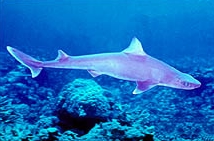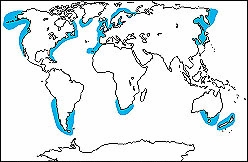
|
|
|
|
|
|
Shark Info (06-15-1999) |
Author |
|
Intro: |
Shark Info |
|
Main article: |
Shark Info |
|
Article 1: |
Dr. T. E. Hopkins |
|
Article 2: |
Dr. A. J. Godknecht |
|
Article 3: |
Dr. E. K. Ritter |
|
Fact Sheet: |
Dr. E. K. Ritter |
|
Fact Sheet: Spiny Dogfish
The spiny dogfish is known primarily by virtue of its largest representative, the real spiny dogfish, Squalus acanthias. But the name "spiny dogfish" is not reserved for this one specific species alone. It covers an entire family of spiny dogfish including, for example, such different forms as Greenland sharks or cookie-cutter sharks. The name "spiny" shark is actually misleading since contrary to expectations, not all species of the group have the typical spines in front of the dorsal fin. Although the species in this family in part look different, they do have one thing in common: the suction holes behind the eyes and the lack of an anal fin. Most species of spiny dogfish actually live quite deep in the ocean. Obviously, this makes their observation in their natural environment very difficult and much of our knowledge on this species is thus speculative. Generally speaking, very little is known about its biology. The best researched species is the real spiny dogfish, Squalus acanthias, whereby here too, knowledge is mostly limited to information relevant to fishing. The biology of the real spiny dogfish (Squalus acanthias)
DistributionThe distribution of the real spiny dogfish is limited (see map) since these animals generally prefer a water temperature ranging between 7 and 15 degrees. Nevertheless, they may well have the largest population of any given shark species. The annual catch along the Massachusetts (USA) coast alone used to amount to approximately 27,000 tons. AgeThe age limit of these animals is still very speculative. Literature sources cite values of 30 and sometimes even a 100 years. FeedingMuch knowledge on the biology of the spiny dogfish is only fragmentary. In 1998, for example, it was discovered that the animals have two separate feeding methods: On the one hand they suck in their food by quickly lowering the lower jaw to produce a kind of suction, and on the other hand some potential prey is rammed before being eaten. Their food palette appears to consist of school fish as well as spineless animals such as crabs or mussels. ReproductionSpiny dogfish reproduce in a way which makes them extremely vulnerable to fishing methods. The age at which they reach sexual maturity is very difficult to determine. Some observations point to 10 to 20 and even 30 years. Such fluctuations may indicate that their habitats are marked by differences. External factors such as water temperature and food supplies may influence sexual maturity as well as the size of the litter which may range between one and twenty animals. Generally, they have an above-average pregnancy period of 18-24 months which is longer compared to other shark species. Usually spiny dogfish do not exceed a length of approximately 120 cm, whereby sexual maturity is usually reached by males measuring 60 to 70 cm and females measuring 70 to 100 cm. Length at birth may be around 22 to 23 cm. If these factors are integrated - late sexual maturity with small litter sizes and a long pregnancy time - it is by no means surprising that excessive fishing has a destructive influence on spiny dogfish populations. Their "slow" reproduction rate does not allow easy restoral of its unstable populations. EnemiesTheir numbers are negatively influenced both by fishing and their relatively small size, which makes them easy prey for other sharks, sea lions and swordfish. BehaviorSpiny dogfish often live in swarms consisting of thousands of animals. These swarms are formed in order to hunt together, but also as protection against enemies. Certain swarms consist of pregnant females in search of their nesting grounds, which include the San Francisco Bay. Females and males usually live in separate swarms. Mixed groups are rare. Males prefer flatter regions while females only return to flat coastal areas to bear their young. Spiny dogfish undertake long migrations, influenced partly by the availability of food and partly by water temperatures, but their migration path has not yet been studied sufficiently. One tagged animal was found to have migrated 6,500 km, but the reasons behind this behavior remain purely speculative. Encounters with humansSpiny dogfish are usually quite harmless, but a poison is secreted at the base of the spines which may lead to complications in humans suffering from allergies.
Additional Literature Cheryl D. Wilga and Philip J. Motta (1998). Conservation and variation in the feeding mechanism of the spiny dogfish Squalus acanthias. J. Exp. Biol 201 (9): 1345-1358. Compagno, L. J. V. (1984). Sharks of the world. FAO Species Catalogue. Vol. 4(2): 111-113. Hanchet, S. (1988). Reproductive biology of Squalus acanthias from the east coast, South Island, New Zealand. N. Z. J. Mar. Freshwater Res. 22: 537-549 Walker, T. I., Taylor, B. L., Hudson, R. J. and J. P. Cottier (1998). Implications on recent increases in catches on the dynamics of Northwest Atlantic spiny dogfish (Squalus acanthias). Fish. Res. 39 (2): 139-164. May be published only by indicating the source: Shark Info |
|
|
|
|
|
|||||

